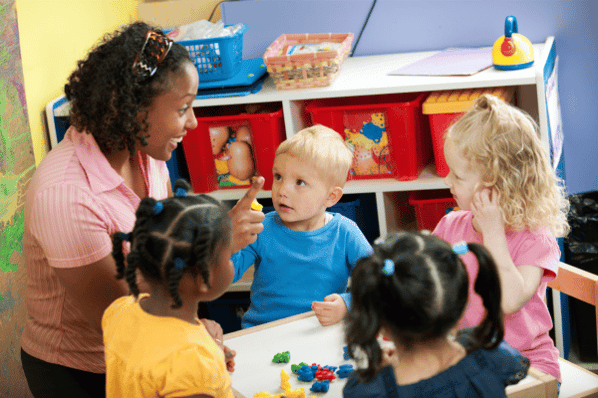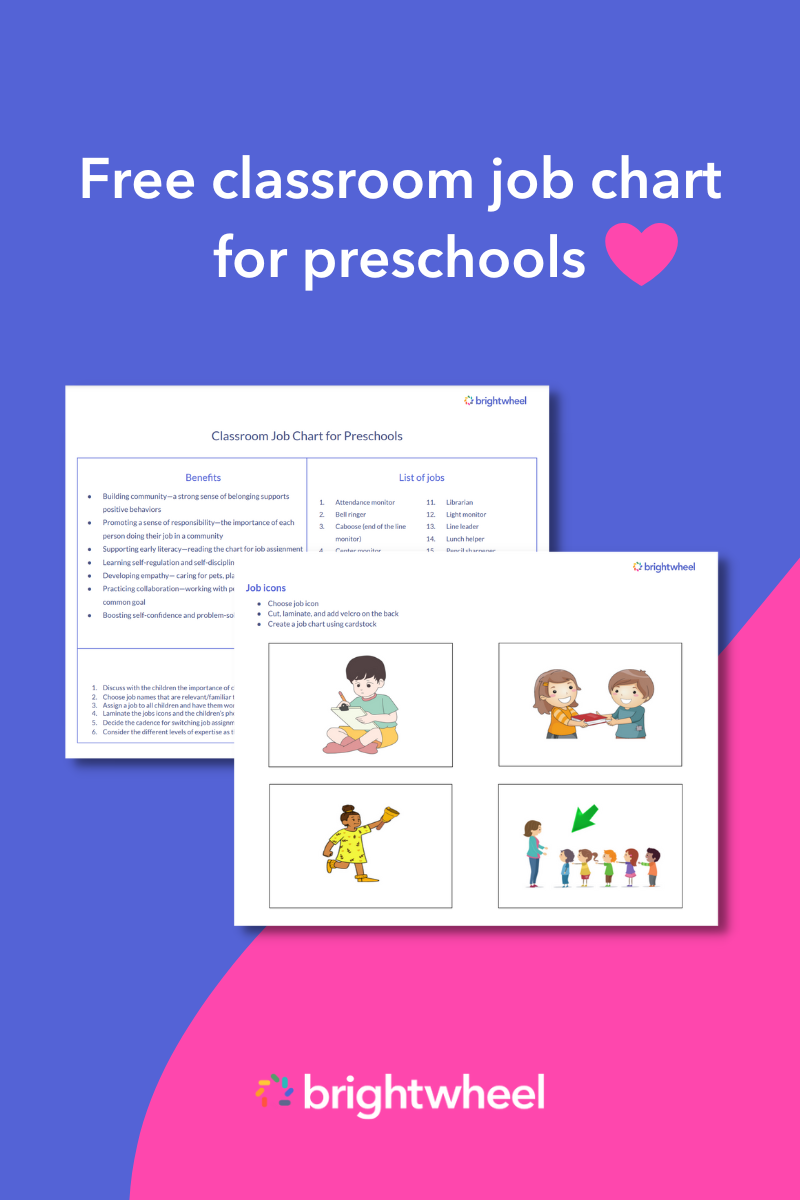
Sometimes young children may display challenging behavior, such as tantrums or not following directions when they are upset about something or don’t know how to express their feelings. Caregivers and teachers play an important role in helping children learn how to cope with and manage their big emotions and impulses, and express themselves in positive ways.
Redirecting behavior is one strategy to use to stop a challenging behavior from escalating. While it may take some time and patience to redirect behavior effectively, it's a valuable skill for all caregivers and educators to have.
What is redirecting behavior?
Redirecting behavior is a technique that involves changing the focus of a child's attention from an undesirable behavior to a more positive one. It interrupts and redirects a child's challenging behavior and attempts to calm them down and avoid further conflict.
With redirecting, the caregiver is still in control, but the child feels like they are too. This helps the child feel more secure, making them less likely to continue the negative behavior.
Redirecting behavior can be used when the child is engaging in a behavior that is:
- Inappropriate
- Harmful
- Disruptive
- Unsafe
- Destructive
Redirecting will look different based on the situation and the child's age. However, it acknowledges the child's feelings, gives them choices, and helps them find a more constructive way to express themselves.
Redirection techniques
Proper redirection techniques defuse a tense moment, prevent the child's behavior from escalating, and teach the child how to cope more positively.
If you feel angry or frustrated, take a deep breath and try to see the situation from the child's perspective. This will help you respond in the best way for both of you.
How to redirect children's behavior
By redirecting, teachers can minimize disruptions and promote a positive learning environment. Try the below strategies to help redirect children from challenging behaviors to more positive ones.
Give them a choice
Giving children a choice gives them a sense of value and also helps build their confidence. For example, instead of saying, "Don't hit your friend," you could offer a choice by saying, "Do you want to hit the pillow or scream into this stuffed animal?"
Ignore the behavior
For children seeking attention, sometimes the best thing you can do is to ignore it. If the child acts out for attention, they will eventually stop if they are not getting the desired reaction. After ignoring them, give positive attention when the child behaves appropriately.
Use a distraction
If you can't ignore the behavior, distract the child with something else. For example, if a child is throwing a tantrum, try offering them a toy or game to play with. If a child is shouting or screaming, lower your voice and ask them gently what the problem is.
Redirect their energy
If the child is acting out because they have too much energy, redirect it into positive activities. For example, if they are running around the house, ask them to run around outside instead.
Give them a hug
Sometimes a child needs physical affection to feel better. For example, if they are acting out of anger or frustration, hug them and let them know you're there for them. Your love and support will help calm them down.
Set clear expectations
If the child doesn't know what is expected of them, they are more likely to misbehave. Set clear expectations from the onset and stick to them. They can learn the consequences if they don't follow the expectations.
Use positive reinforcement
When the child exhibits good behavior, fortify it with positive reinforcement such as praise, rewards, or privileges. Positive reinforcement can encourage things like sharing or following directions.
Avoid power struggles
Arguing with a child is usually unproductive and often escalates a situation. If the child is misbehaving because they want to control, engaging in a power struggle will only give them what they want. Be calm, control yourself, and avoid getting into a shouting match with the child.
Don't take it personally
Remember that challenging behavior is not personal. The child is not doing it to spite you or to be difficult. They are still learning how to manage their emotions and navigate their feelings.
Types of redirecting behavior
Caregivers and educators often need to redirect children's behavior to keep them safe, on track, and focused. The below commonly used methods will help you positively achieve this goal.
Verbal redirection
Use your words to change the child's focus. If your child is about to touch a hot stove, you might say, "No, that's hot. Let's touch this cold block instead."
Physical redirection
This is applied when verbal attempts don't work or aren't appropriate. With this method, you physically guide the child away from the problem behavior and towards a more positive one. For example, if your child is hitting another child, you might take their hand and lead them to a different activity.
Redirecting with a cue
This redirecting behavior uses visual or auditory cues to get the child's attention. For example, if you see your child about to run into the street, you might yell, "Stop!" or wave your arms to get their attention.
Redirecting attention
This method involves drawing a child’s attention to a positive example of behavior in a child’s surroundings. For example, if a child is throwing toys, a teacher might point out a nearby child playing quietly and appropriately with their toys.

Pros and cons of redirecting behavior
Even though redirecting behavior can be a successful teaching technique, there are pros and cons to using this approach, and it is essential to consider both sides before deciding whether or not to use it in a specific situation.
Pros:
- Prevents further escalation of the behavior: Some behavior, if left unchecked, will escalate and become much more challenging to deal with. Redirecting the behavior early on prevents this from happening.
- Allows the child to avoid embarrassment: Redirection can be used in public without embarrassing the child, which is often a concern with other behavior management techniques such as scolding or sending a child to time-out.
- Provides a teaching moment: Redirecting shows the child a more appropriate way to behave. This is often more effective than simply telling the child what not to do because it provides them with a model to follow.
- Is not a punishment: Correcting a behavior through redirection is often more effective than a negative consequence, such as sending a child to time-out or taking away a privilege. This technique helps to encourage a particular behavior in a positive way.
Cons:
- Does not address the root cause: Redirecting behavior does not always address the underlying cause of the behavior. For example, if the child is acting out because they are feeling frustrated, angry, or anxious, simply redirecting the behavior will not address these emotions.
- Can be challenging to do at the moment: It requires a lot of patience and practice to effectively redirect a child's behavior in the heat of the moment.
- May be confusing for the child: If the child is not used to this technique, they may not understand why their behavior is being redirected. This may lead to frustration or confusion.
- Does not always work: Some children will not respond to this technique no matter how often it is used. In these cases, consider other behavior management techniques.
With a tool like brightwheel's classroom management feature, your teachers can message families directly and share classroom highlights and milestones instantly. This allows your staff to build positive relationships with families and easily track observations about children's progress.
Redirecting behavior examples
There are different types of redirection techniques that teachers and caregivers can use to reinforce positive behavior. Below are some examples of both verbal and physical ways to redirect children's behavior.
Verbal redirection examples
Here are some examples of statements to verbally redirect a challenging behavior:
- “I see you're feeling frustrated. Let's take a break and return to this in a few minutes.”
- “It looks like you're having difficulty staying in your seat. Why don't we try taking a quick walk around the room before sitting down again?”
- “It looks like you're having a lot of fun with that toy. But now it’s time for our friend to have a turn.”
- “Throwing toys is not safe. Let’s go outside and throw a ball around instead.”
- “Let’s use our inside voices to answer the question.”
Physical redirection examples
Here are day-to-day examples of how you might redirect a child's behavior using physical redirection by offering an alternative behavior to the child:
- If a child is running around the room, you might say, “It's time to walk now.” Then, take their hand and help them walk.
- If a child is hitting a toy, you might say, “Let’s use gentle hands,” and then demonstrate how to play with the toy gently.
- If a child is biting, you might say, “Here, bite this instead,” and offer them a teething ring to chew on.
- If a child is climbing on furniture, you might say, “It's not safe to climb on furniture. Let’s go outside and climb on the playground.” This shows them an alternative behavior that is more appropriate.
- If a child is throwing a tantrum, you might say, “It's time to calm down now,” and then help them find a quiet place to sit or lie down.
Classroom behavior management
Effective preschool behavior management strategies improve children's engagement, reduce disruptive behavior, and promote a harmonious classroom atmosphere. It can be challenging to manage behavior, but here are key strategies to use:
Establish clear rules and routines
Children need to know what is expected of them to behave appropriately. Therefore, be clear and concise when communicating expectations to avoid confusion.
Having a set routine will also let children know what comes next and what is expected of them throughout the day. A good routine helps reduce disruptive behavior as children feel more comfortable and secure when they know what to expect.
One way to set good routines in your classroom is to assign children classroom jobs. Use a job chart to give children a visual aid of their task for the day or the week. Classroom jobs give children the opportunity to help out in the classroom and promote responsibility and collaboration.
Model appropriate behavior
Children learn best by observing and imitating the adults in their lives. Teachers can model appropriate behavior, so children learn how to behave appropriately. This includes speaking politely, using indoor voices, and walking in line.
Use logical consequences
Logical consequences are those that are directly related to the child's behavior. For example, if a child is not following the rules, they may lose privileges or have to take a break from activities. Logical consequences teach children that there are natural consequences to their actions and help them to understand cause and effect. Make the consequences fair and consistent so that children know what to expect.
Practice proactive planning
Proactive planning is a technique that helps teachers prepare for potential problems before they occur. This includes having a plan for dealing with common disruptive behaviors, such as talking out of turn or not paying attention. Then, you can respond quickly and effectively to the behavior so that it does not escalate or become a bigger problem.
Planning also prevents problem behavior from happening in the first place. This involves changing the environment, providing engaging and challenging activities, or giving clear instructions.
Encourage classroom involvement
When all class members, including the teacher and the children, actively engage in learning, there is less disruptive behavior. Therefore, plan exciting and engaging lessons, and provide opportunities for all children to participate.
Engage with families
Establishing a positive, trusting relationship with families can be beneficial when dealing with challenging behavior. Communicate your behavior management strategies with families so they can continue them at home if necessary. This way families can provide consistent expectations to their child and reinforce the same positive behavior you are teaching in the classroom.
Final thoughts
Redirecting challenging behavior helps children learn to control their emotions and impulses, develop coping skills for dealing with stressful situations, build positive relationships with others, and become more successful in school and life. With patience, creativity, and a willingness to try different techniques, you can turn negative actions into positive behavior.
Brightwheel is the complete solution for early education providers, enabling you to streamline your center’s operations and build a stand-out reputation. Brightwheel connects the most critical aspects of running your center—including sign in and out, parent communications, tuition billing, and licensing and compliance—in one easy-to-use tool, along with providing best-in-class customer support and coaching. Brightwheel is trusted by thousands of early education centers and millions of parents. Learn more at mybrightwheel.com.

